
Guide
10 beautiful chairs – in my opinion
by Pia Seidel

Sit on every chair you come across. This is one of Esther Angulo's tricks to recognise good design. What else does she look out for when choosing a dining chair?
Looking for a suitable chair design can quickly become overwhelming. Our range of chairs comprises over 5,000 styles. As dining chairs are often a big investment because you buy more than one, I asked expert Esther Angulo for her advice. The interior designer has sourced countless pieces of furniture for both private and public projects. Hotel Walther in Pontresina and restaurant il baretto (in German) in Zurich are just two examples. I met Esther at her home in Basel. «You have to make a checklist and ask targeted questions at the start,» she suggests, «then simulate and get creative.»
«Being able to sit for a long time, comfortable, playful, flexible – I write down key words like this at the start,» explains Esther. Before you even start thinking about aesthetics, she recommends that you make a checklist of properties. This ensures that your needs are fulfilled later. Then and only then do appearance and precise specifications come into play.
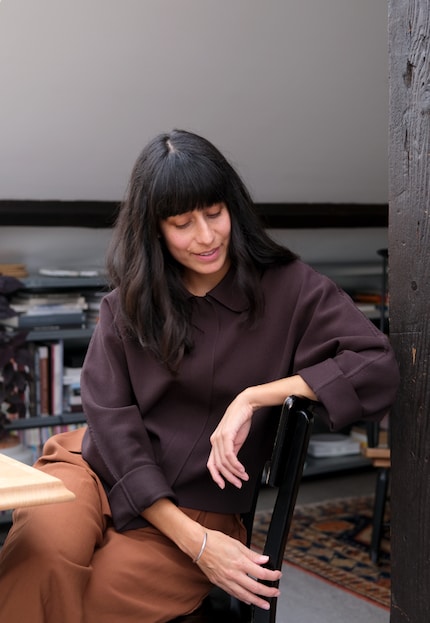
This is why Esther asks her private clients questions about their habits, such as how the chair will be used with other furniture like a dining table. Elements including room size, architectural features and what furniture is already there are also relevant. «A light wooden chair without armrests or cushions is ideal for a small kitchen. In an area where a lot of cooking takes place and things can splash, washable surfaces or water-repellent fabrics are advantageous.»
A chair is like a roommate that has to work with you.
Once the questionnaire is complete, Esther moves on to reference images. If her client has specific ideas, she integrates their images into her research. The result is a collage – a mood board. She then adds her own material, which she finds on social media or in her extensive photo collection from showroom and trade fair visits. This way, she ensures that everyone shares the same vision.
If there is already a dining table, Esther asks for its dimensions first. «You shouldn't sit too low at the table,» she explains. «Otherwise, you feel like a small child and tend to pull up your elbows and shoulders. It can work in exceptional cases, but you need more to feel comfortable.» Older people also find it difficult to get up from low chairs like lounge chairs. Books like [«Bauentwurfslehre»](in German)(https://www.galaxus.ch/en/s11/product/bauentwurfslehre-ernst-neufert-technology-books-8873228) by Neufert are a great reference. Among other things, they provide information on standard spacing or components of living areas, churches, offices and much more. Between 40 and 47 centimetres from floor to seat is considered comfortable. There are also 48 centimetre-high chairs in some restaurants. «This can often be too high and feel uncomfortable if your feet don't touch the ground,» adds Esther.

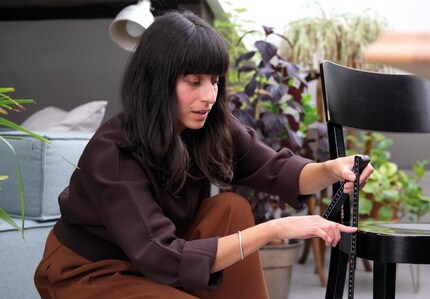
To test what chair height is best for you, she recommends simulations. «You've always got a chair at home that you can use for measurements. Place a book underneath, for example, so that you can envisage the height and see how you feel.»
There should be 23–28 centimetres of distance between the tabletop and seat. This allows you to cross your legs. More than 28 centimetres, though, will make you feel like you're sitting at a children's table. Other furniture or the wall should be at least a metre away. 65 centimetres is the optimal distance between chairs so that you can extend your elbows without bothering the people next to you.
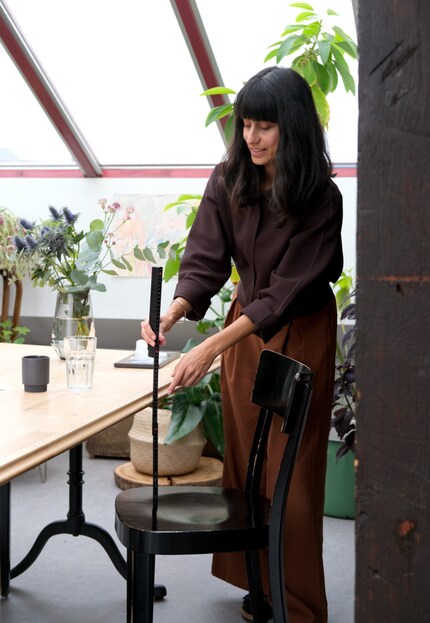

It's always worth trying out a chair, whether you're in a shop, at a hotel or at a friend's house. «You should be able to stretch and move back without it wobbling or creaking,» says Esther. «If you want to sit on someone's lap after dinner, the chair shouldn't collapse straight away.»
How much you move while you're eating dictates whether armrests are right for you. If you're not sure whether they'll bother you, Esther advises combining different chairs – both with and without armrests. Ultimately, they need more room and affect the distance between the chair and the table. «Make sure the armrests fit under the table,» she adds. «That way you won't lose any space.» Chairs with short armrests are an alternative. They offer comfort and fit at least partly under low tables.
Esther isn't keen on metal for home use or surfaces in direct contact with skin. It's cold and can feel uncomfortable. She avoids closed plastic seats because you stick to them in the summer and moisture can't escape because of the bad air circulation. Along with wood, Esther prefers cushioned chairs or styles which only have a cushioned seat. «Cushions invite you to linger,» she explains. «A soft surface feels nice, particularly on bare skin.» The interior designer ensures that the material is waterproofed. Looking at it, you can't see the difference. But if there's a spillage, the liquid will simply run off. She also asks the manufacturer whether the material can be replaced or the chair can be reupholstered if anything goes wrong. This isn't that cheap, but it's worth it in the long run.
Esther chooses chairs for her projects based on environmentally-friendly criteria. It's important to her that a chair or its parts haven't been flown half way around the world. She prefers to recommend beautiful designs from Switzerland and Europe for her projects. She advises finding out how easy repairs are in advance in case they're needed. «In the gastronomical world, being able to order replacement elements is essential,» she explains. «Specialist furniture makers for the public sector ensure this and design companies like Vitra offer a good service. This is often different when it comes to retailers of cheaper chairs.»
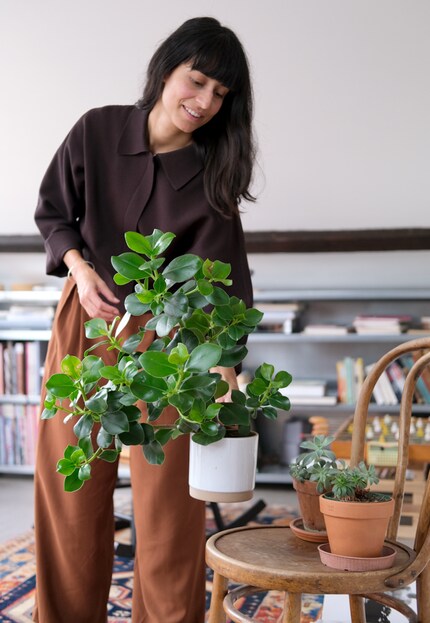
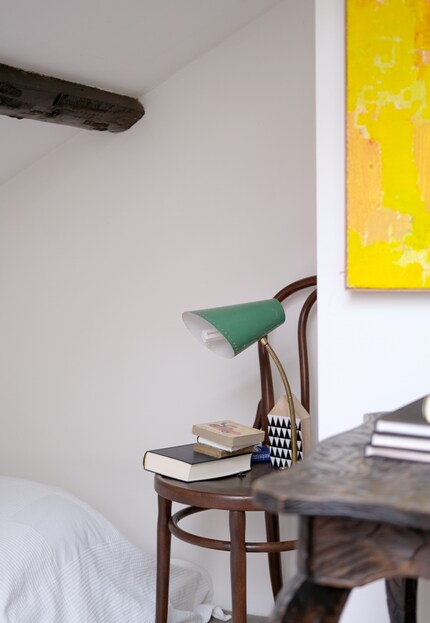
Lifting and examining the chair helps to determine the quality: how is it made? Is it glued or screwed together? In any case, there are good, inexpensive chairs out there. Signs of bad quality include plastic screws rather than metal ones. Then there are downright classics: Esther owns a set of second-hand «Classic» chairs by Horgenglarus. «Chairs by Swiss manufacturers are so durable because they have good joints and are made from solid wood that ages beautifully, among other things.» In other words, quality wood and a good surface treatment will make a chair more durable. Esther broaches this subject with manufacturers too. How has the chair been treated? Is it varnished or oiled, and how does it have to be maintained? It's also worth taking a look at the weight of online purchases. This will give you an idea of how stable the design is.
A detail that's often overlooked is flooring Certain brands provide suitable furniture glides for your floor if you ask,» explains Esther. Alternatively, there are plastic and screw-in felt glides for parquet floors and metal ones for carpets or synthetic flooring. Felt glides are impractical on carpets because they aren't able to glide. She advises against self-adhesive felt glides for chairs: «They're often visible and quickly fall off. Either that, or unsightly dust gathers on them.»
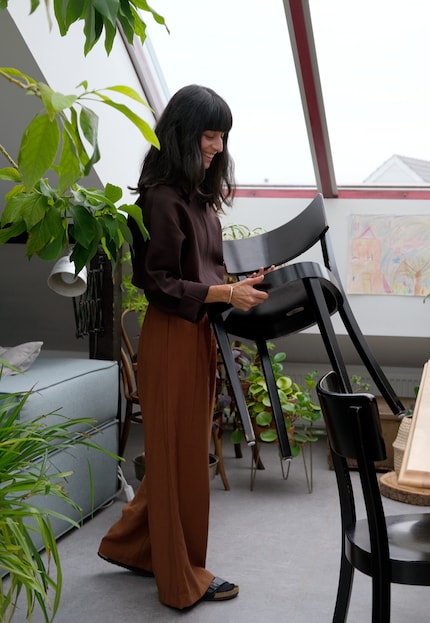
Chairs can break up the look of rooms and shape the overall aesthetic. «It should be harmonious, but a striking, elaborate design quickly adds to the whole room,» adds Esther. Chairs like the famous Eames Plastic Chair by Charles and Ray Eames are known for this and revered as a design object. They're often incorrectly described as Vitra chairs. The phenomenon can be explained by successful marketing (by Vitra) and the wow effect: elements like the colourful seat shell and braces draw the eye.
Every interior needs something vibrant. I like to have exotic furniture and eye-catching pieces here and there.
However, chairs like Horgenglarus ones impress with clear, subtle shapes. If in doubt, you can combine different chairs. «That's what we did at Hotel Walther,» she explains. There are four different styles with upholstery fabric in the dining room. It keeps things fresh.
Esther's interior design is shaped by the different places she has worked. She started out with interior designer Iria Degen in Zurich, whose reputation is for classic, elegant style. Then she moved to Copenhagen to work for David Thulstrup. The studio's projects are known for their Scandinavian minimal chic. Virginia Maissen gave her an appreciation for the eclectic. The Zurich interior designer is known for her free spirit and knack for vintage furniture. Esther Angulo now works for architect [Rolf Stalder](in German)(https://www.rolfstalder.ch/). Among other things, she's involved in developing an interior design department and redesigning a restaurant and hotel in Birsfelden on the outskirts of Basel. Today, she describes her style as classic, timeless and relaxed. «A space needs something powerful alongside a harmonious combination and at least one eye-catching element in the room to give it some character.»
Like a cheerleader, I love celebrating good design and bringing you closer to everything furniture- and interior design- related. I regularly curate simple yet sophisticated interior ideas, report on trends and interview creative minds about their work.
Practical solutions for everyday problems with technology, household hacks and much more.
Show all